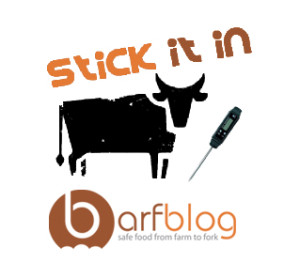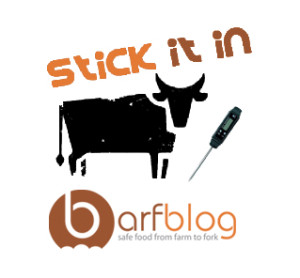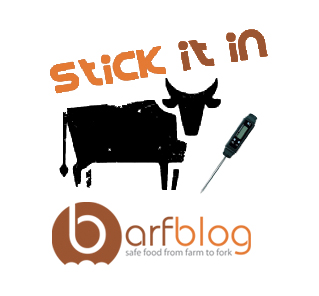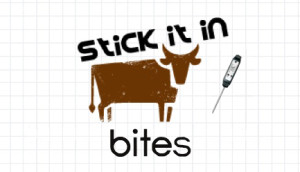When Liz Szabo of USA Today called me a few weeks ago, my immediate thought was, not another food safety tip story, because most of them are as exciting as watching soccer or listening to Springsteen.
 But, I changed my mind because anyone can be a critic – gotta come up with some solutions.
But, I changed my mind because anyone can be a critic – gotta come up with some solutions.
I told Liz, let me talk to some of my colleagues and we’ll take a shot at something decent, because food safety encompasses a lot of areas, and the older I get, the less I know.
(Below is an edited version of the story, with a few annotations from me.
Doug Powell doesn’t bring wine when he’s invited to dinner.
He brings a food thermometer.
(I do bring wine, and I sometimes forget the thermometer, like the trip we’re on now up at Rainbow beach and Fraser Island in Queensland). Consistency matters and I try, but sometimes, stuff happens.)
As a food safety scientist and creator of barfblog.com, Powell knows way too much about the dangers of undercooked meat to take chances on the barbecue.
 So he brings a food thermometer to every summer cookout. “I don’t get invited to dinner much,” he says.
So he brings a food thermometer to every summer cookout. “I don’t get invited to dinner much,” he says.
• Always use a meat thermometer, Powell says. With practice, people can learn to stick them in burgers without slicing the patties in half. “Pick the meat up with tongs and insert the thermometer sideways, or through the top,” Powell suggests. Beef hamburgers should reach 160 degrees to kill germs, says Benjamin Chapman, assistant professor of food safety at North Carolina State University and a food safety specialist at the North Carolina Cooperative Extension. Temperature matters far more than color when it comes to meat, Chapman says; even thoroughly browned burgers can harbor bugs. “I was not a popular person at a family cookout a few years back when I insisted we ‘temp’ the chicken as we grilled in the rain,” says Donald Schaffner, a professor and extension specialist at Rutgers University in New Jersey. “But nobody got sick.”
• Slice your own cantaloupes. Although cantaloupes are loaded with vitamins, they’ve also caused some of the biggest outbreaks of food-borne illness in recent years. More than 260 people were sickened in a salmonella outbreak in 2012; nearly 100 were hospitalized and three died, according to the Centers for Disease Control and Prevention. Cantaloupes spread disease more easily than watermelon or honeydew because their soft, bumpy skins soak up bacteria like a sponge, Powell says. Washing doesn’t help (much), and cutting  through the outer rind allows bacteria to infect the edible portion of the melon. While people don’t have to stop eating cantaloupes, they should keep sliced portions refrigerated, because cold temperatures slow bacterial growth. But stores are asking for trouble when they slice melons in half, wrap them in plastic and leave them at room temperature in the produce aisle, Powell says: “This is microbiological disaster waiting to happen.”
through the outer rind allows bacteria to infect the edible portion of the melon. While people don’t have to stop eating cantaloupes, they should keep sliced portions refrigerated, because cold temperatures slow bacterial growth. But stores are asking for trouble when they slice melons in half, wrap them in plastic and leave them at room temperature in the produce aisle, Powell says: “This is microbiological disaster waiting to happen.”
• Use a cooler — for cantaloupe, potato salad or other picnic foods. “Bacteria will grow if left out at warm temperatures long enough,” Powell says.
• But don’t be afraid of mayonnaise. The egg-based spread has gotten a bad rap, and some people have been afraid to take it on summer picnics. But “commercial mayo uses pasteurized eggs and has high levels of vinegar,” whose acid content helps control bacteria, Powell says. Homemade mayo, on the other hand, could be riskier. (See https://barfblog.com/wp-content/uploads/2014/03/raw-egg-related-outbreaks-australia-3-3-14.xlsx
• Don’t wash poultry and other meat. “It just spreads bugs,” Powell says.
 So are there any foods these three food experts won’t touch?
So are there any foods these three food experts won’t touch?
• Sprouts. Seeds and beans need warm, humid conditions to sprout and grow. So do bacteria, such as salmonella, listeria and E. coli. Raw or lightly cooked sprouts have caused at least 30 reported outbreaks of food-borne illness since 1996, according to FoodSafety.gov. Home-grown sprouts are no safer, because the bacteria can be found in the seeds themselves. So no matter how clean your house, bacteria can grow to dangerous levels. “Some providers test seed and provide sufficient controls, but consumers have no way of knowing which sprouts are good or not,” Powell says.
• Raw shellfish. Even a fancy dish such as raw oysters, served in high-end restaurants, can pose a huge risk, Powell says, because they can be exposed to raw waste while under water. “The bacteria Vibrio found on raw oysters produces a toxin that attacks vulnerable livers,” Powell says. “Raw shellfish is risky.”
• Raw milk can also contain dangerous bacteria, including salmonella, listeria, campylobacter and brucella, according to the CDC. Younger children, old people and those with weak immune systems are most at risk. “Getting sick from raw milk can mean many days of diarrhea, stomach cramping, and vomiting,” the CDC says. “Less commonly, it can mean kidney failure, paralysis, chronic disorders and even death.”
 The Gold Coast Bulletin reports that two French fine-dining chefs say there’s been a countrywide “dumbing down” of the burger and they’re fighting back with fresher flavor.
The Gold Coast Bulletin reports that two French fine-dining chefs say there’s been a countrywide “dumbing down” of the burger and they’re fighting back with fresher flavor.












